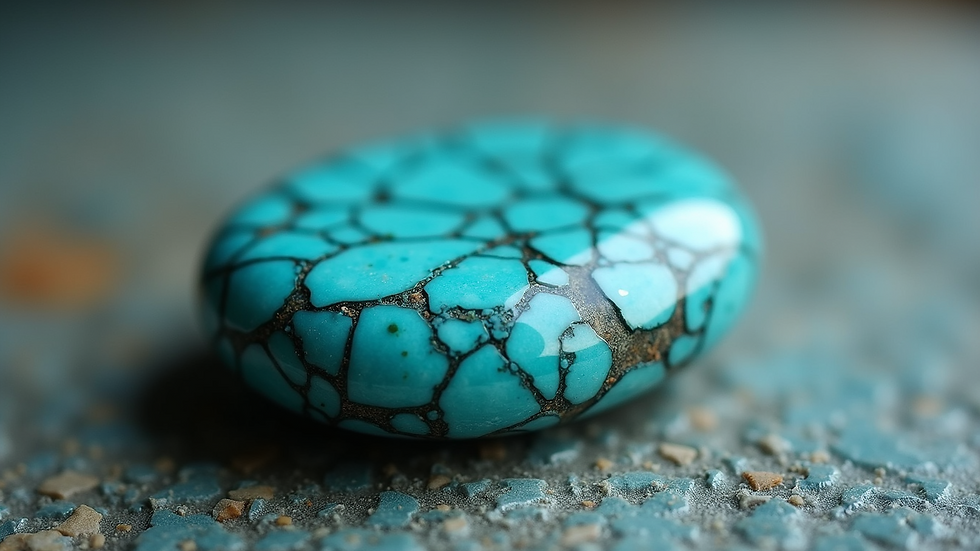Unveiling the Origins of Turquoise
- Sep 29
- 4 min read
Turquoise has captivated human imagination for thousands of years. Its vibrant blue-green hues evoke the vast skies and tranquil seas, making it a gemstone unlike any other. As I delve into the origins of turquoise, I find myself tracing the journey of this remarkable stone from deep within the earth to the hands of artisans and collectors. This exploration reveals not only the geological processes that create turquoise but also the rich cultural tapestry woven around it.
The Geological Origins of Turquoise
Turquoise forms through a fascinating natural process. It is a hydrated phosphate of copper and aluminum, created when water percolates through rocks containing copper deposits. Over time, this water dissolves minerals and redeposits them in cracks and cavities, gradually forming turquoise. This process can take millions of years, resulting in the stone’s unique matrix patterns and colors.
The most prized turquoise often comes from arid regions where copper-rich rocks are abundant. The southwestern United States, Iran, Egypt, and China are some of the most famous sources. Each location imparts distinct characteristics to the turquoise, influenced by the local mineral content and environmental conditions.
The color spectrum of turquoise ranges from sky blue to greenish hues. The presence of copper typically gives the stone its blue color, while iron can add green tones. The matrix, or the veining within the stone, is often a dark brown or black web-like pattern, adding to its visual appeal.

Understanding these geological origins helps collectors and designers appreciate the natural artistry behind each piece. It also guides them in identifying authentic turquoise and distinguishing it from imitations.
Exploring the Origins of Turquoise in Human History
Turquoise has a storied past that stretches back thousands of years. Ancient civilizations prized it not only for its beauty but also for its symbolic and spiritual significance. The history of turquoise is rich with tales of trade, craftsmanship, and cultural reverence.
In ancient Egypt, turquoise was mined in the Sinai Peninsula and used extensively in jewelry and amulets. The Egyptians believed it brought protection and good fortune. Similarly, in Persia (modern-day Iran), turquoise adorned the domes of mosques and was considered a symbol of heaven on earth.
The Native American tribes of the southwestern United States also hold turquoise in high esteem. For them, it represents life, health, and protection. Turquoise jewelry and artifacts have been found in archaeological sites dating back over a thousand years, highlighting its long-standing importance.
The stone’s journey through history is a testament to its enduring allure. It has crossed continents and cultures, each adding layers of meaning and craftsmanship. This historical context enriches the experience of owning or designing with turquoise, connecting the present to a vibrant past.

How Did Native Americans Get Turquoise?
The Native American tribes of the Southwest, including the Navajo, Zuni, and Hopi, have a deep connection to turquoise. They obtained this precious stone through mining and trade, often from local deposits in Arizona, New Mexico, and Nevada.
Mining turquoise was a labor-intensive process. Miners used hand tools to extract the stone from veins within the earth. The turquoise was then carefully cleaned and shaped by skilled artisans. These craftsmen transformed raw turquoise into intricate jewelry pieces, such as necklaces, bracelets, and rings, often combined with silver.
Trade networks also played a crucial role. Turquoise was exchanged among tribes and with neighboring cultures, spreading its influence and availability. This exchange helped establish turquoise as a symbol of status and spiritual power.
The Native American approach to turquoise is not merely commercial; it is deeply spiritual. Many tribes believe turquoise connects the wearer to the sky and water, elements essential to life. This belief imbues each piece with meaning beyond its physical beauty.

Practical Tips for Collectors and Jewelry Designers
For those passionate about turquoise, understanding its origins is just the beginning. Here are some practical recommendations to enhance your collection or design work:
Verify Authenticity: Genuine turquoise has a unique matrix and color variation. Be cautious of dyed howlite or magnesite, which are common imitations.
Know Your Sources: Different mines produce distinct turquoise types. For example, Sleeping Beauty turquoise from Arizona is known for its pure sky blue color, while the Kingman mine offers a range of blues and greens.
Consider Treatment: Some turquoise is stabilized to improve durability. While this is common, untreated turquoise is often more valuable to collectors.
Design with Contrast: Turquoise pairs beautifully with silver, gold, and even leather. Use contrasting materials to highlight its vibrant color.
Care for Your Pieces: Turquoise is relatively soft and porous. Avoid exposure to chemicals, perfumes, and prolonged sunlight to maintain its luster.
By applying these tips, collectors and designers can ensure their turquoise pieces remain stunning and meaningful for years to come.
The Enduring Legacy of Turquoise
The story of turquoise is one of nature’s artistry meeting human creativity. From its geological birth deep underground to its revered status in cultures worldwide, turquoise continues to inspire. Each stone carries a fragment of earth’s history and a whisper of ancient traditions.
As I reflect on the origins of turquoise, I am reminded that this gemstone is more than just a mineral. It is a bridge between past and present, a symbol of beauty and resilience. Whether displayed in a collector’s cabinet or worn as a cherished piece of jewelry, turquoise holds a timeless appeal.
For those who seek to explore this gemstone further, resources like Turquoise in America offer a wealth of knowledge and access to rare, high-quality pieces. Embracing the origins of turquoise enriches our appreciation and deepens our connection to this extraordinary stone.
May your journey with turquoise be as vibrant and enduring as the stone itself.


Comments